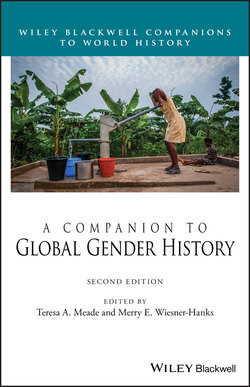Читать книгу A Companion to Global Gender History - Группа авторов - Страница 43
Chapter Five Gender Rules: Law and Politics
ОглавлениеSusan Kingsley Kent
Law, Freud theorized in a number of his later works, first arose when a primitive band of brothers rose up to kill their authoritarian father, who had monopolized sexual access to the women in their tribe. Out of their shame and guilt in committing parricide and in engaging in sexual intercourse with women of close relation, they produced three rules –the taboos against parricide and incest, and the proclamation of equality amongst the brothers – which established, Freud argued, the foundation of law in human society (Pateman, 1988). In yet another example of the many efforts over the course of centuries in virtually every culture in the world to explain how human societies and polities came into existence, Freud attributed to a conflict in gender and sexual relationships the development of a legal and political system that operated to bring civilization to prehistoric peoples. His story, of course, is no more accurate or real than any of those that had gone before, but it serves as a useful example of the ways in which gender and law and politics have been inextricably intertwined in myths about the origins of human society, in theories of law and politics, and in the workings of law and politics in everyday life. It gives vivid witness to Joan Scott’s pathbreaking theory that gender – what we’ve construed to be the sexual differences between men and women – is one of the most significant and oft‐used means by which we articulate and represent relations of power (Scott, 1988).
Almost everywhere we look, whether it be ancient Greece or Rome, medieval China or Europe, Renaissance Italy, precolonial Africa, indigenous America, early modern England, or revolutionary America or France, political elites told themselves and their subjects and constituents stories about how their societies had first emerged and how the right to exercise power and to make law had come to rest with them. In virtually all of these cultures, whether ruled by divine‐right absolute monarchs, hereditary aristocracies, or councils of citizens, law and politics depended upon a model of familial, and thus gender and sexual, relations for their conceptualization. Kinship, it appears, served as the model not only for most forms of social organization but for most forms of political ordering as well.
This may seem commonsensical, almost natural, but it is vital to remember that family, gender, and sexual arrangements are always fashioned within particular political, social, economic, and cultural circumstances. In consequence, they have differing effects for individuals according to gender; any legal and political worldview that depends upon a certain familial model will replicate those differing effects for individuals according to gender. Thus, a social order based on patriarchy, in which the law of the father over his wife and children prevails, underpins a political ordering in which authority rests with men, producing laws and relations of authority in which women and underage males suffer disabilities. Attempts to ameliorate such political and legal disabilities necessarily have to challenge the legitimating theories or cosmologies that inform them. This situation helps to explain why eighteenth‐century French revolutionaries turned to an idiom of brotherhood or fraternity to justify and narrate the toppling of their absolute monarch; and why feminists in the nineteenth and twentieth centuries, looking to implement a social and political order that would recognize and value women as full citizens, sought out historical or anthropological examples of matriarchy through which they could demonstrate that a previous “natural” order of beneficent and egalitarian women‐controlled and women‐dominated societies had been overthrown by authoritarian, inegalitarian patriarchal orders. In both instances, they sought to establish their own mythologies of law and politics that legitimated their contemporary political aims.
